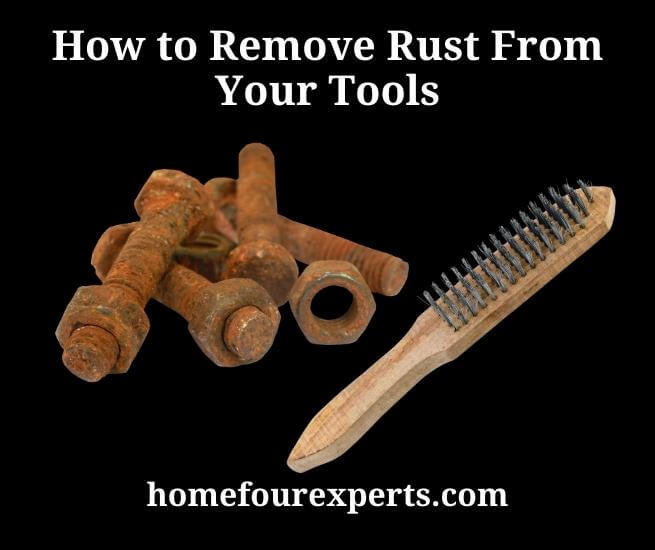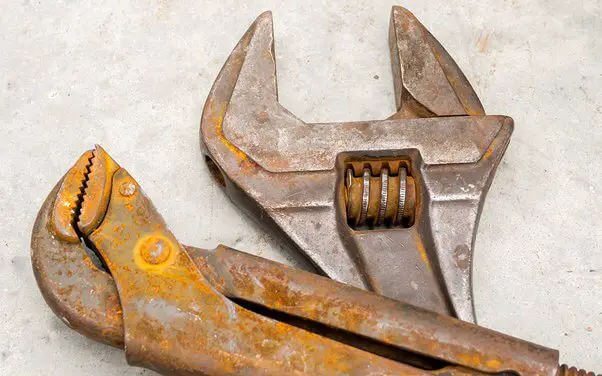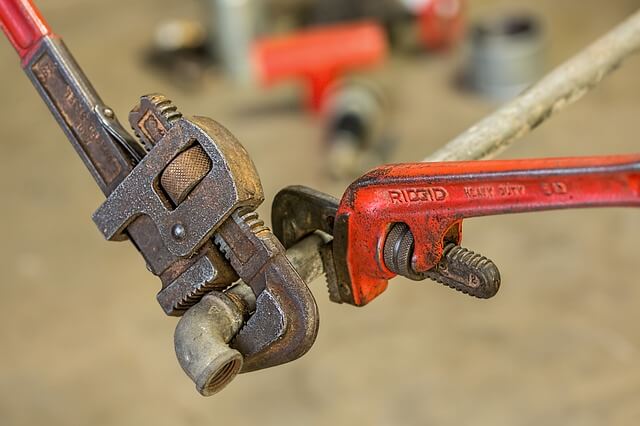Every professional or DIY hobbyist must experience rusty tools in their toolbox. The question is do you throw them out or try to clean them?
Rust can be the biggest threat to the utility of your tools as it spreads gradually like a contagious disease. So you must make some time to check your tools and clean them.

There are different methods of removing rust from your tool but today I’m going to introduce you to the most effective three of them.
But before going to the point you should know about rust so that you can have an idea about the reason for rust on your tools.
Know About Rust
Rust is the product of a chemical reaction of a chemical named iron oxide. It is a specific example of corrosion when metal like steel or iron reacts with oxygen & water. According to Oxford Dictionaries, “A reddish- or yellowish-brown flaking coating of iron oxide that is formed on iron or steel by oxidation, especially in the presence of moisture.”
How to Remove Rust
It is very common to have rust on your tools often. If you have any tools like this, don’t throw them out so quickly. Because it is possible to remove rust from your favorite tool. You can remove rust from your tool in many ways-
By soaking them in a detergent and water mixture then scrubbing them with sandpaper or steel wool,
Or soak your tool in vinegar and salt mixture and scrub them with sandpaper,

Or you can also use chemicals like oxalic acid to remove rust.
To make you clear I’ve discussed all of these 3 methods in detail:
1. Sanding Rust:
You can remove rust from your tools in this way by following these simple steps-
Wash Your Tool:
First thing first! You need to wash out grease and dirt from your tool. For this, mix a grease-cutting detergent with warm water now put your tool in the mixture and rub them with a sponge to clean the dirt and oil then remove them from the water and let them dry.
Scrub the Rust:
Next step is to scrub the rust with steel wool or sandpaper to remove the rust from your tool. Start scrubbing with coarse grit because it’ll make it easy to scrape off the rust. Change the sandpaper whenever it gets dull.
Rinse and Dry Your Tool:
The last step of this method is to rinse the tool with clean and running water. Then dry them using a clean cloth and make sure that your tool is completely dry.
Note: If your tool has rust after using this method, you may need to use chemical remover.
2. Vinegar & Salt:
For using this method, follow the mentioned steps-
Prepare Your Tool:
First of all, you need to prepare your tool for removing rust by using vinegar and salt. Because your tool may be attached to any wooden or other material. In this case, disassemble your tool then wash it in detergent and warm water mixture.
Place Your Tool in a Large Container:
Now place your tools in a large, plastic toolbox so that it is submerged in the water.
Pour Vinegar:
Cover the tool with white vinegar. White vinegar has acidic ingredients which help to cut through the rust and make easy to clean the tool. Track the amount of vinegar you added to measure the right amount of salt.
Add Salt:
Now time to add salt to the vinegar and spread it evenly in the vinegar. The ratio of adding salt to vinegar is 1/4 cup for 1- liter of vinegar.
Salt increases the acidity level of the vinegar so that it helps to dissolve rust quickly.
Soak for a Few Days:
Let your tool soak in the mixture for 1- 3 days. Because the mixture needs some time to break down the rust so that it can be scrubbed easily from the tools.
Scrub the Tool:
Remove your tool from the solution and scrub it with a scouring pad until the rust is removed from the tool.
Clean the Container:
Pour out the vinegar solution and wash it with clean water and fill the container with clean water as much as vinegar.
Add Baking Soda:
Add baking soda to the water in the same ratio as vinegar and salt. Baking soda helps to neutralize the acid from vinegar so it will not remain in your tool.
Place the Tools:
Now place the tools into the water and soak them in the solution for ten minutes. Then dry them with clean water.
Scrub the Tool:
Scrub your tool with steel wool to remove the remaining rust from it.
Wipe the Tool:
Finally, wipe the tool with denatured alcohol. Apply the alcohol to a clean cloth and rub it onto your tools. It’ll help to remove water from your tool

3. Using Oxalic Acid:
To use oxalic acid you must follow these steps carefully-
Get the Acid:
purchase the acid from a hardware store. Oxalic acid works more quickly than natural methods.
Wear Safety Gear:
To protect your eyes and skin you must use goggles and a rubber glove before using the acid.
Wash the Tool:
Wash away the grease and dirt from the tool using soapy water as mentioned earlier.
Prepare the Container:
Take a large container and add 1 gallon or 4 liters of water to it.
Add the Acid:
In the container add 3 tablespoons of oxalic acid and mix it very carefully without splashing on yourself or on the work area.
Soak the Tools:
Add your tools to the water and let them sit for 20 minutes.
Rinse the Tools:
After 20 minutes remove your tools from the solution and rinse them with clean, running water. And finally, dry them properly using a clean, dry towel.
Note: To avoid lung irritation, choose a well-ventilated place to complete the process.
There Are Several Types of Rust Removal
| Name | Details |
| Natural Rust Removers | The technique of vinegar is straightforward. You can completely lower the rusted part of your device over a container or plastic cup and let it splash for now. You can rub lemons directly on the rust, the most effective way is to use enough lemon juice so that they can be covered for the time being. You can add some salt for extra sharpness. |
| Coke and Aluminum | It’s an exemplary strategy that works so well that it puts pressure on you to get stuffed. Use Coke to fill a container or small tub to minimize your devices. As usual, soak them for a couple of hours. |
| WD-40 | This normal splash can remove light rust if you let it soak for about 10 minutes and rub a little. |
| Kerosene or Diesel | Both of these gases can go around as a rust intruder. Try not to use acetones as they may remove the sealant from your device. |
Best Methods for Removing Rust From Tools
1. Use a wire brush, steel wool, or sandpaper to scrub off rust.
2. Use an acidic rust remover such as white vinegar or lemon juice.
3. Apply a commercial rust remover such as WD-40 or Rust-Oleum.
4. Soak the tool in a bath of cola.
5. Apply a paste made of baking soda and water.
6. Use a specialty rust-removing product such as Naval Jelly or Rust Free.
7. Use a power tool, such as a drill, to grind off the rust.
What Materials Do I Need to Remove Rust From My Tools
1. Wire brush
2. Steel wool
3. Sandpaper
4. White vinegar
5. Lemon juice
6. Baking soda
7. WD-40
8. Rust remover
9. Rust converter
10. Metal polish
Are There Any Risks Associated With Using Chemical Solutions to Remove Rust
Yes, there are risks associated with using chemical solutions to remove rust. Chemical solutions are highly corrosive and can cause burns, irritation, and other health risks if not handled properly. Depending on the chemical used, there may be environmental risks. Make sure to read the label of any chemical solution you use and follow all safety instructions.
Conclusion
So these are the most used method for cleaning rust from your valuable tools. If you’re going to clean your tool for the first time, I’d suggest you follow the first method because it is safer than others.
If you are experienced or confident enough you can choose any method I’ve mentioned to remove rust from tools.
I always prefer natural methods for this purpose as using chemicals has the risk of getting injured during the process.
Relevant Resources:
- Reviews of Ladders for Gutter Cleaning
- 6 Easy Steps to Clean a Table Saw Blade
- Do I Need a Permit to Replace My Garage Door
- Are 394 And 395 Batteries the Same?
About This Writer

Hi, I am Eric Devin and I am a professional interior architect. Since childhood, I've always enjoyed DIY projects! And, I have loved to solve simple household problems using essential tools and equipment. I have also acquired a lot of information about basic household tools settings by working with contractors.